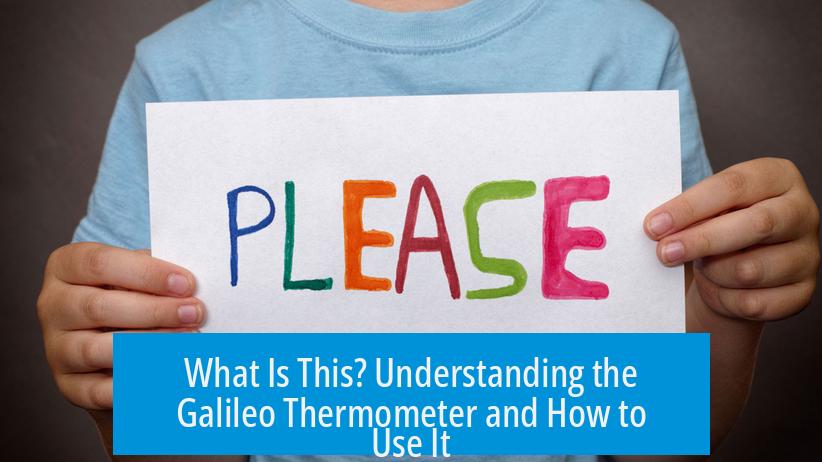What Is This? Understanding the Galileo Thermometer and How to Use It

This object is a Galileo thermometer, a decorative and functional device that measures ambient temperature by using liquid density changes. It consists of a sealed glass cylinder filled with a liquid and several floating glass bulbs. Each bulb has a metal tag indicating a specific temperature. The position of these bulbs within the liquid reflects the approximate room temperature.
Identification of the Object

The device is known as a Galileo thermometer, named after Galileo Galilei, the Italian scientist who discovered the principle of buoyancy affected by density changes in liquids. It is also called a Galilean thermometer or, less accurately, a Galileo mercury thermometer, although it contains no mercury.
- The thermometer contains multiple glass bulbs, each weighted differently.
- Each bulb has a small metal tag engraved with a temperature value, typically marked every 2 to 4 degrees Celsius.
- The entire collection of bulbs floats in a transparent liquid within a sealed container.
How the Galileo Thermometer Works

The core principle involves the density of a liquid varying with temperature changes. When the ambient temperature changes, the liquid inside the glass cylinder expands or contracts.
- As the liquid’s density changes, the relative buoyancy of the glass bulbs shifts.
- Bulbs with densities higher than that of the liquid sink; those with lower densities float.
- The changing positions of the bulbs serve as indicators of the current temperature.
In essence, the metal tags act as calibrated counterweights, each calibrated precisely to reflect a certain temperature by adjusting the bulb’s density. This lets each bulb rise or fall within the liquid based on the temperature-induced density of the liquid surrounding them.
How to Use the Galileo Thermometer
Using the Galileo thermometer is straightforward but unlike modern digital thermometers, it requires visual interpretation.
- Look carefully at the floating bulbs inside the liquid container.
- Identify the lowest glass bulb that is floating near the top of the liquid but not sunk.
- The metal tag attached to this lowest floating bulb indicates the approximate current temperature of the space.
- If all bulbs float at the top, the temperature is below the lowest marked bulb’s temperature.
- If all bulbs sink, the temperature is above the highest marked bulb’s temperature.
For example, if the bulbs are graduated in 4-degree increments, and the lowest floating bulb shows 22°C, the room temperature is near 22 degrees Celsius.
You do not need to interact physically with the thermometer. Simply observe the bulb positions to read the temperature. The thermometer is designed as both a practical tool and decorative piece.
Practical Uses and Considerations
The Galileo thermometer is primarily used indoors and functions best in stable temperature environments.
- It makes a fine decorative element for homes or offices
- It offers a visual and engaging way to gauge temperature fluctuations without electronics
- Accuracy is approximate; it is not a precision instrument for scientific or medical use
- It is fragile; the glass and liquid inside can break if dropped or mishandled
In some households, it serves more as an art piece than a practical thermometer. Users report it adds a touch of classic science and beauty to rooms.
Additional Notes
There are myths or jokes about the thermometer’s use circulating online, but the Galileo thermometer’s sole function is measuring ambient temperature via liquid density differences and floating bulbs. It is neither a laboratory tool nor a device with any other utility.
If a bulb remains fixed or doesn’t respond to temperature changes, the device might be old or malfunctioning. Temperatures below or above the thermometer’s calibrated range result in all bulbs floating or sinking.
Summary: Key Points
- The object is a Galileo thermometer measuring temperature by liquid density changes.
- Each bulb’s position corresponds to a temperature, marked on metal tags.
- Read the temperature by noting the lowest floating bulb’s tag.
- It serves decorative and approximate temperature-measuring functions indoors.
- It requires no active use beyond observation and is fragile.
For more detailed scientific and historical information, the Wikipedia article on Galileo thermometers offers a comprehensive overview.
What is This? Please Tell Me How to Use It
It’s a Galileo thermometer, a stylish device that tells the temperature by how colorful glass bubbles float or sink inside a liquid-filled tube. Sounds simple, right? Let’s dive into what it is exactly and how you can use this nifty gadget, without accidentally turning it into a quirky paperweight or your pet’s new favorite toy.
So… What Is a Galileo Thermometer?
First off, this isn’t just any thermometer. It’s a Galileo thermometer, named after the famous Italian scientist Galileo Galilei. The logic is pretty elegant: it uses the principle that liquid density changes with temperature. When the temperature shifts, the density of the clear liquid inside the sealed glass tube changes, causing the colorful glass orbs inside to rise or fall.
Each orb floats because it’s carefully weighted with a metal tag indicating a specific temperature. The trick? Each bubble has a unique density designed to “match” the surrounding liquid at a certain temperature. When the room temperature changes, some bulbs sink, others float.
In practical terms, the temperature closest to you is shown by the lowest floating orb. So if you see a blue bubble just barely bobbing above the rest, check its little metal tag for your room’s approximate temperature. Easy and elegant.
How Does It Work? The Science Behind the Art
Imagine the liquid in that glass expands or contracts as the air temperature changes. When it expands in warmth, it’s less dense. When it contracts in cold, it’s denser. So, the glass bubbles, weighted precisely with their metal tags, adjust their buoyancy.
The weighted tags act like calibrated counterbalances. At a higher temperature, some bubbles sink because they weigh more than the less dense liquid. At a lower temperature, those same bubbles float. This dance of bubbles reveals the ambient temperature with surprising accuracy.
How to Use a Galileo Thermometer? Actually, How NOT to Use It
- Don’t sit on it. Seriously, that joke might have floated around, but the glasstube is delicate and breaks instead of supporting your exquisite derrière.
- Look at the tags. Each metal tag is engraved with a number and degree symbol, telling you the temperature it corresponds to. Find the lowest bubble that’s floating freely in the tube — that temperature is your room temperature.
- Ignore the idea of poking or shaking it. This won’t speed up the reading or calibrate it better. Just place it somewhere stable and watch it do its thing.
- Enjoy the decoration. Many owners (including yours truly) love these thermometers for their eye-candy design as much as their function. If you want a thermometer that doubles as art, this is a winner.
Is It Only Decorative? Can It Replace My High-Tech Weather Station?
The answer is nuanced. Yes, it’s a functional thermometer with historical charm. But it’s not a lab-grade device for precise scientific measurement. It’s perfect for indoor or mild outdoor conditions, offering an approximate temperature rather than exact degrees.
Many people keep them around as desk ornaments or conversation starters. One owner mentioned their cat knocked theirs off the desk—ouch. So handle with care. Still, most users find them reliable for telling if the room is cool, warm, or somewhere in between.
Some Practical Tips and Anecdotes
- Check the tags every once in a while to learn how their numbers relate to your living space’s temperature shifts.
- If all the bubbles float near the top, the temperature is probably below the lowest tag value. Think of it as cold weather’s artistic “all float” signal.
- Likewise, if all bubbles sink, it’s hotter than the highest tag—but this handily tells you it’s warm or hot.
- From personal experience (and some user reports), these thermometers can last years—unless your cat fancies smashing them.
A Quick Comparison: Galileo Thermometer vs. Digital Thermometers
| Feature | Galileo Thermometer | Digital Thermometer |
|---|---|---|
| Design | Elegant and decorative | Functional, often plain |
| Accuracy | Approximate | Highly precise |
| Durability | Fragile glass | Robust plastic or metal |
| Ease of Reading | Requires interpretation of tags | Instant numeric display |
| Use Case | Home décor and casual temperature check | Medical, lab, or HVAC use |
Final Verdict: Why Use It?
If you want a thermometer that doubles as a conversation starter and brings a bit of old-school science charm to your room, the Galileo thermometer is your friend. It’s an easy-to-use, mostly decorative gadget with reliable temperature indications.
You don’t have to fiddle to make it work. Just place it on your desk, shelf, or window sill and watch science float in action. The lowest floating bubble shows your approximate room temperature. Simple physics, a pinch of art, and zero batteries required.
Curious to try one? Just don’t let it collect dust or become the next cat casualty!
For a deeper dive, check out this Wikipedia page on Galileo thermometers.
What is a Galileo thermometer?
It’s a decorative device that measures temperature. Inside, colored glass balls float or sink in a liquid. Each ball has a metal tag showing a specific temperature.
How do I read the temperature on it?
Look at the lowest floating ball. The metal tag on this ball shows the current temperature roughly. Each tag usually jumps by about 4 degrees.
Why do the balls move up and down?
The liquid changes density as temperature shifts. When density changes, the glass balls either float or sink depending on their weight, indicating the temperature.
Do I need to do anything else to use it?
No setup is needed. Just place it in a room and watch. It works by itself. It’s mostly a stylish thermometer for decoration.
Can this thermometer be used outdoors?
It’s mainly for indoor use. Temperature changes inside a room affect the balls. Outdoors, wind or direct sun may affect its accuracy.
Is the Galileo thermometer fragile?
Yes, it’s made of glass and can break if dropped. Handle it with care to keep it intact and working properly.





Leave a Comment